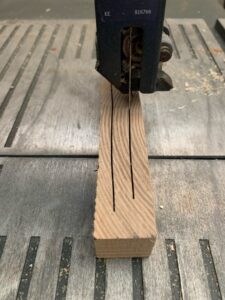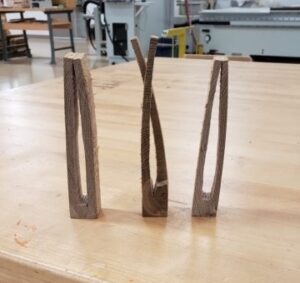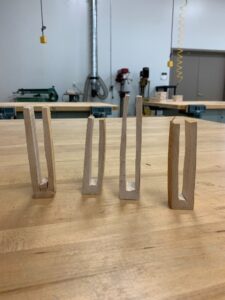By Scott Lyon, WI DNR Forest Products Specialist
Lumber manufactured into interior wood products (e.g., furniture, flooring, millwork, cabinets) typically requires kiln drying to reach a targeted moisture content to minimize dimensional changes. In Wisconsin, this dry-basis moisture content is 6-8%. Not only does kiln drying allow the wood to equalize to desirable and usable moisture content, it kills fungi and insects that might be present in the lumber.
However, drying stress—commonly called casehardening or tension set—occurs during the drying process. Casehardening is a normal part of the drying process of lumber. It is critically important to relieve this stress as it can lead to warping and twisting when lumber is later re-sawn or machined.
As lumber dries, the surface first loses moisture causing wetness from the inner portion of the board to move outward toward the surface, where it evaporates. This process causes a moisture gradient to form between the low-moisture content in the shell and the high moisture content in the core. As the moisture starts to move out of the board, the wood begins to shrink. The initial shrinkage can cause defects if not carefully maintained.
If dried too quickly, the force of shrinkage can exceed the strength of the lumber, and surface checks (i.e., small cracks) or end checks (i.e., cracks at the ends of the boards) will form. These cracks form as a result of the core in compression and the shell in tension. As drying continues, the core begins to shrink and, as it does, the shell is forced into a state of compression while the core remains in tension. Surface checks may close as drying continues, making the lumber look normal; however, stress is still present unless it is relieved at the end of the drying process.
How Can You Tell If Lumber Has Stress Or Casehardening?
Casehardening is often noticeable during the machining of lumber. If a woodworker is re-sawing or ripping lumber into smaller cuttings, the stresses are relieved, and unacceptable warping (such as cup and crook) often manifests. This can cause the wood to pinch the saw blade and become a safety hazard to the operator. Additionally, casehardening stresses can significantly impact yield when re-sawing or re-manufacturing lumber. Other than encountering stress during machining, another way to test lumber at the end of the drying process is by cutting samples for stress testing.
A helpful way to monitor the moisture content and watch for any drying defects during the drying process is to use kiln samples. Kiln samples allow the operator to control the kiln better and determine when to adjust the drying time, ultimately improving lumber quality. Also, these samples will help determine when the lumber’s moisture content is equalized and conditioned, which will properly relieve drying stresses.
To conduct a stress test, cut a 1-inch section across the width of the sample board at least 12 inches from the end of the board. The core section is removed with a bandsaw (Figure 1). The time it takes for the prongs to move inward or outward is a good indication of how significant the residual drying stresses are. If the two outer prongs pinch together or bypass each other immediately (Figure 2), the board has casehardening or tension set.
The pinching occurs because of the tension stress in the core. When the bandsaw removes the core, the prongs move inward. In severe casehardening, the prongs may snap together or bypass each other. To determine if casehardening or a moisture gradient is present, the sample will need to rest for 12 hours while it is monitored to detect any changes resulting from moisture loss.
If immediate prong movement occurs, followed by additional prong movement after 12 hours of rest, both casehardening and moisture gradient are present. In either case, prong movement in a stress test points to a condition that should be corrected to avoid warp during re-sawing or machining. Prongs will remain fixed if the wood is conditioned correctly (Figure 3). Once casehardening or moisture gradient is observed, additional stress relief and/or equalization are required.

Figure 1. Core section being removed by bandsaw from the stress test sample.

Figure 2. Prong test samples showing casehardening present in the lumber. The middle sample shows the severity of the casehardening present by cutting a piece to allow the prongs to bypass each other.

Figure 3. Prong test samples showing little or no casehardening present.
Preventing Casehardening During Drying
Temperature, relative humidity and air velocity are the factors that control the rate of lumber drying. Stresses in lumber are strongly influenced by the temperature and relative humidity of the environment during drying. It is important to understand how to control different factors throughout the drying process to reduce or remove stresses and produce a quality product. Air-dried lumber or lumber dried in a solar kiln may have little stress present because the high relative humidity each morning relieves some of the stress naturally. However, air-dried lumber might not be suitable for interior applications because it will have a higher final moisture content and could have powder post beetles or other insects present.
During the final stage of the drying process, when the lumber is near the desirable moisture content of 6-8%, the variability in moisture content between the boards is reduced. Boards are equalized (i.e., brought to the same moisture content) by drying the boards below the target moisture content by two percentage points. For example, if the target moisture content is 8%, the lumber is equalized to 6%. This reduction allows the target moisture content to be achieved during the final process of conditioning.
During conditioning, steam is supplied to the kiln chamber. The steam relieves drying stresses that formed during drying. The addition of steam raises the final moisture content of the lumber from 6% in our equalizing example to the final target moisture content of 8%. At that stage, the boards should be stress-free and should remain straight when machined or re-sawn. If warping occurs, then the drying stress has not been fully relieved. A helpful way of conditioning lumber in a dehumidification kiln is to use a garment steamer. It might be necessary to conduct several stress tests to determine if the garment steamer has applied enough steam to the lumber in the kiln.
For more information on drying lumber, please visit the U.S. Department of Forestry’s webpage or the Forest Products Laboratory’s webpage.
